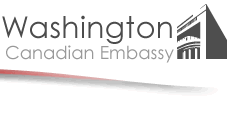|
Home    Defence, Security and Foreign Policy Defence, Security and Foreign Policy    Canada's Immigration Policies Canada's Immigration Policies
Numerous misperceptions exist in the United States regarding Canada’s immigration policies. Here are a few and the actual situation: Some of the 9/11 Hi-jackers entered through Canada: FALSE.
This is simply not true. The 9-11 Commission devoted considerable research to this issue and found that none of the 9-11 hijackers had entered the United States through Canada. The 9-11 hijackers had all entered the United States with U.S. visas. Anyone can immigrate to Canada: FALSE.
It is not easier to qualify to immigrate to Canada. As in the United States, immigration in Canada is regulated by comprehensive legislation that allows for the admission of persons who meet legislative requirements and the denial of entry to those who pose a threat to public safety or national security. In 2005, over 260,000 legal immigrants were admitted to Canada. That same year, the United States accepted approximately 1.1 million legal immigrants. The mix of immigrant categories and source countries of immigrants are different for the two countries, but all must meet statutory criteria related to security, criminality and medical requirements. Canada’s highly trained visa officers screen ALL immigrant applicants abroad to protect the safety and security of Canadians. Canada works with partners to target and intercept security threats before they arrive in North America. Canada has Migration Integrity Officers in 39 locations abroad who assist airlines in identifying improperly documented persons attempting to board flights to Canada. In the past five years, these officers have intercepted more than 30,000 improperly documented persons. Canada does not detain illegal immigrants: FALSE.
In Canada, the legal basis for detention is substantively the same as in the United States. Individuals who represent a danger to the public, pose a security threat or are deemed to be a flight risk may be detained. In the case of persons seeking asylum or refugee status, a security screening assessment is completed before they are released in Canada. Canada has a large number of illegal immigrants: FALSE.
It is estimated that 12 million persons are in the United States without legal status. While it is difficult to ascertain the precise number of undocumented persons in Canada, some media estimates run as high as 300,000 whereas many experts believe 100,000 or less to be a more likely estimate. The number of illegal, undocumented immigrants in the United States increases by at least half a million persons per year — twice the number of legal, fully-screened immigrants entering Canada each year. The Northern and the Southern U.S. borders are the same: FALSE.
There are significant differences in the size and scale of illegal activities along the northern and southern borders. In 2005, the US Border Patrol intercepted approximately 1.2 million improperly documented persons on the south-western border compared to less than 10,000 along the northern border sectors, an area identified as within 100 miles of the Canadian border. The Canada-U.S. Smart Border Declaration and Action Plan, signed on December, 12, 2001, encompasses key immigration-related action steps, including joint registered traveler programs such as NEXUS, visa policy coordination, sharing advance passenger information, managing refugee/asylum processing and the removal of deportees. Together Canada and the United States have made important progress toward strengthening the secure movement of people between the two countries. | 




